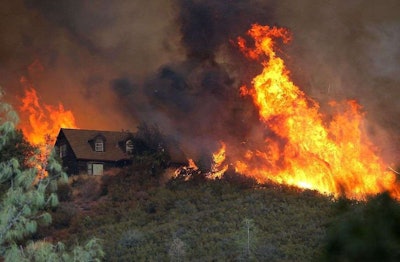 Photo: Wikipedia
Photo: WikipediaFire was said to be stolen from the gods as a gift to mankind, but as wildfires rip through Northern California it seems more like a curse.
The cause of the sparks remains a mystery for now, but as for why these blazes have been particularly destructive is due to the mixture of abundant fuel and the oh-so-aptly named Diablo winds fanning the flames with gusts up to 70 mph in the past few days.
“The conditions are just ripe – the recipe is just right,” Amy Head, spokeswoman for the California Department of Forest and Fire Protection, told Insurance Journal.
The reason why California has become a veritable tinderbox this year comes from three different factors. First, the state is still coming out of a six-year drought where about 102 million trees died, leaving them vulnerable to embers. Secondly, when California did receive its drought-busting rains this winter it caused a copious amount vegetation to come back, only to get dried out by a scorching summer.
“The long-term drought is over, but there’s still the legacy of that drought in terms of stressed forests,” Daniel Swain, a climate scientist at UCLA told Inside Climate News. “And on top of that we had a wet winter, which meant that the grasses and brush grew like crazy this spring.”
The final factor for the bounty of burnable substances is due to a century of aggressive fire suppression. Without fires naturally purging forests, the density of forests is much higher than in the past. These packed forests are more vulnerable to catastrophic fires.
At least 170,000 acres of wine country have been burned by these ongoing fires with at least 26 people dead and hundreds more missing.
Part of the reason why more people and structures have been affected in recent wildfires is due to homes being constructed in hilly communities near brush and woodlands, known as the urban-wildland interface.
“This is what was so extraordinary about this event,” Swain told Inside Climate News. “Essentially it was a forest fire, a wildfire, that moved into an urban area. At some point, it was jumping from house to house, not tree to tree.”
State law requires homeowners to have a defensible space around their homes as a way to increase houses’ chances of surviving a wildfire and protecting firefighters defending the property. To learn more about firescaping and the different zones, click here.
As extreme drought becomes more of common occurrence for California, the Public Policy Institute of California has proposed several different approaches to stop wildfires in drought-parched lands. It advises the state in improving forest health by the strategic removal of high-density smaller trees and fuels.
It advises the usage of prescribed fire, managed fire and mechanical thinning as ways to increase the long-term resilience of headwater forests.
“I think understanding the role of fire and the necessity of it in the landscape, having the public appreciate the role that fires play in keeping forests healthy, is something we could improve upon,” Van Bustic, a land system scientist who works at the University of California, Berkley, told Water Deeply. “We need to build up the social license to do treatments.”










